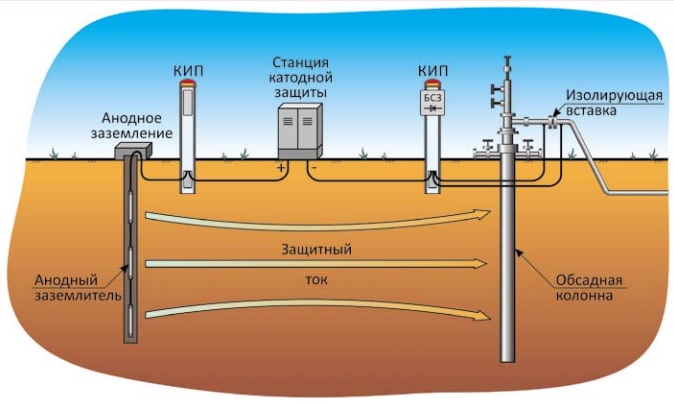Well drilling for electrochemical protection in Tyumen
When drilling wells in soil with increased corrosive activity, it is imperative to use electrochemical protection for all types of underground structures. The amount of metals that are annually dissolved in the soil of the Earth is estimated at millions of tons and worsens the ecological situation on the planet. Drilling wells for electrochemical protection allows you to protect a gas pipeline or an oil pipeline from corrosion (soil or corrosion by stray currents).
Why is electrochemical protection of gas pipelines necessary?
If we are talking about corrosion of ordinary water pipes, then the only thing that it threatens is water leakage and economic losses of the enterprise associated with this fact. But when a leak occurs from a gas pipeline, the situation takes on a much more catastrophic scale and consequences. This is especially true for gas pipelines with medium and high pressure. It is precisely because of the differences in pipeline systems that various electrochemical protection of gas pipelines is used.
There are two main types of gas pipeline corrosion protection: active and passive.
Passive pipeline protection
If we are talking about passive ECS of a gas pipeline, then it consists in covering the pipes of the system with an insulating material (anti-corrosion, bituminous or polyethylene-based material).
Unfortunately, it is not necessary to speak about the high reliability of this method due to the difficulties with the integrity of the insulating coating. The construction of systems using passive corrosion protection has a negative effect on the coating material. Cracks, dents, chips and other defects that have appeared are aggravated during the operation of underground structures and systems. There may also be through damage to the insulation coating, where groundwater can flow, forming corrosion.
Thus, we conclude that the passive method cannot fully protect the pipeline from corrosion. That is why experts recommend using two types of protection at the same time - both passive and active.
Active pipeline protection
The active type of protection is the electrochemical protection of pipelines. It allows you to solve the following tasks:
- suppression of currents in places where they exit into the soil and the creation of anode zones in places with a damaged insulating layer;
- removal of dangerous stray currents.
Stray currents can occur for various reasons. For example, due to the operation of nearby trams, railways, welding machines and similar electrical equipment.
Let us dwell in more detail on the principle of operation of the active type of exch pipelines. It allows you to reject stray currents due to the presence of an anode protection circuit or with the help of a cathode station that converts alternating current to direct current.
It is also possible to install another electrochemical installation - using deep grounding. In this case, a ground electrode is installed in wells specially drilled for this purpose with a clay solution, the length of which is greater than its diameter. This is not the whole structure. In addition, a pipe with a welded cone is lowered into the well. An electrode is lowered inside the cone, to which the wires are screwed. They are brought outside and connected to a cathodic protection station, and the wells are covered with coke breeze.
Drilling wells is a very important job that requires an understanding of all technical processes, experience and professionalism. If you need to perform this type of work, then contact BurVoda72 in Tyumen.We operate throughout the region and provide a full range of services related to drilling wells. Qualitatively and on time - that's our motto! Call 8 919 931 34 24 or leave a request on the website.
Do you have any questions? Call by phone +7 3452 930-317
3 Requirements for GRPSh
(New edition. Rev. No. 2)
6.3.1* It is recommended to place the HRPSH equipment in a cabinet made of non-combustible materials, and for heated HRPSH - with non-combustible insulation.
GRPSh are placed separately on supports made of non-combustible materials or on the outer walls of buildings for which they are intended to supply gas, taking into account the permissible sound pressure level. On the outer walls of buildings, the placement of gas-heated gas-fired GRPS is not recommended.
It is allowed to place the GRPSh below the ground level, while such a GRPSh should be classified as a stand-alone one.
(Changed edition. Rev. No. 2)
6.3.2* GRPSh with inlet gas pressure up to 0.3 MPa inclusive is installed:
- on the outer walls of gasified residential, public, administrative and household buildings, regardless of the degree of fire resistance and the class of constructive fire hazard at a gas flow rate of up to 50 m3 / h;
- on the outer walls of gasified residential, public, including administrative, office and household buildings not lower than the degree of fire resistance III and not lower than the structural fire hazard class C1 at a gas flow rate of up to 400 m3 / h.
(Changed edition. Rev. No. 2)
6.3.3* GRPSh with an inlet gas pressure of up to 0.6 MPa inclusive is allowed to be installed on the outer walls of industrial buildings, boiler rooms, public and domestic industrial buildings with rooms of categories B4, D and D and boiler rooms.
6.3.4* GRPSH with an inlet gas pressure of more than 0.6 MPa are not allowed to be installed on the outer walls of buildings.
(Changed edition. Rev. No. 2)
6.3.5* When installing GRPSh with an inlet gas pressure of up to 0.3 MPa inclusive on the outer walls of buildings, the distance from the GRPSh wall to windows, doors and other openings must be at least 1 m, and with an inlet gas pressure of more than 0.3 to 0 .6 MPa inclusive - not less than 3 m. When placing a free-standing GRPSh with an inlet gas pressure of up to 0.3 MPa inclusive, it should be placed with an offset from the openings of buildings at a distance of at least 1 m.
(Changed edition. Rev. No. 2)
6.3.6* It is allowed to place GRPSh on roof coverings with non-combustible insulation of gasified industrial buildings of fire resistance degrees I-II, constructive fire hazard class C0 from the side of the exit to the roof at a distance of at least 5 m from the exit.
(Changed edition. Rev. No. 2)
Types of anode grounding
To ensure cathodic protection of metal objects, 2 main types of anode ground electrodes are used: surface and deep.

To reduce the cost of this design without loss of quality, modern models are made of a special iron-silicon alloy resistant to corrosion. Almost all surface grounding conductors have a rod shape with a round casting and securely insulated places for connecting the contact wire to the grounding conductor. The number of anode protection rods must be calculated by a specialist.
Each rod is connected to the main line using thermite welding or special clamps. In order for the earth electrode to serve for at least 35 years, it should be sprinkled with a coke-mineral composition, which helps to reduce the process of anode decomposition in the soil.

The mass of the device is also significantly increased due to the additional load from the coke-mineral substance, which covers this device.The cost of installing this type of anode grounding is increased by the use of mechanized drilling. If it is impossible to carry out drilling using self-propelled machines, installation of deep grounding can be carried out using portable drilling rigs.
Despite the much more complicated process of installing such equipment, this type of anode grounding electrode is able to protect metal objects located in the soil at a considerable distance. This method of anode grounding is especially effective in urban conditions, when numerous installation work on the installation of surface ground electrodes is very difficult or impossible.
These devices can significantly reduce energy costs, due to the greater range of the device, while the shielding effect is significantly reduced due to the lower density of the installed anode protection objects. The anode grounding resistance of this type does not depend on the season. The electrode is located at a depth that excludes freezing of the soil, which is also an indisputable advantage of this method.
Specifics and regulations
The distance from the cable to the gas pipeline, as well as other parameters that relate to the transportation of electricity through an electric cable and gas fuel through a gas pipeline, are provided for by special instructions for construction, operation and safety.

The rules for the installation of electrical installations provide for a variety of complexities and subtleties that can only arise when placing electrical power panels. They can be group, external or internal.
It is impossible to answer the question of what distance should be observed between the gas pipeline and the electric cable, if the specific features of the engineering project are not taken into account, because the standards depend on several parameters in each case.
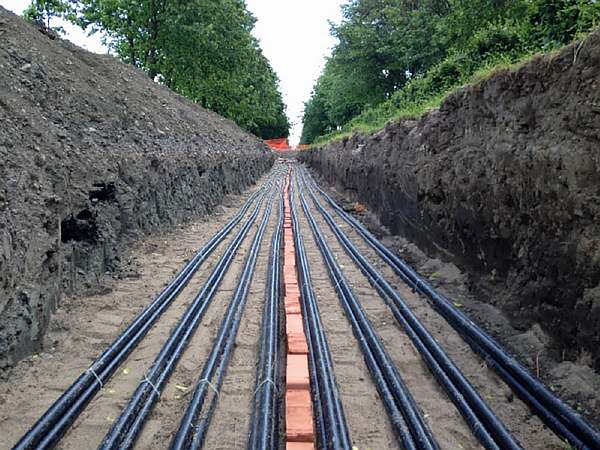
Recommendations have been repeatedly made to the prescribed norms. This happened with the improvement of isolation methods, modifications of transportation, development and branching of networks.
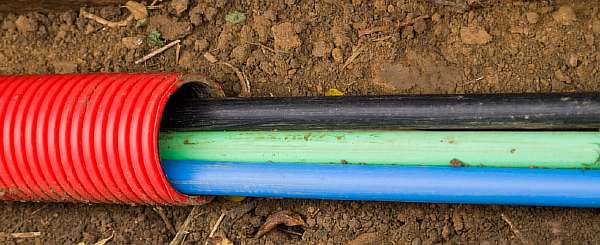
In the case of a pipeline, the distance is regulated according to separate principles. It all depends on the type and variety of the special structure, its technical equipment, the prescribed pressure level in the gas pipeline, as well as the place and method of its laying:
- In SP 62.13330.2011 "Gas distribution systems", supplemented and revised by SNiP 42-01-2002 (it is accompanied by a table of minimum distances from gas pipelines, which organically follow from the safety standards and rules described in the code).
- The PB (FNiP) approved in 2013 provide for industrial safety features for those facilities that use hydrocarbon fuel in a liquefied state.
- The Decree of the Government of the Russian Federation, adopted on November 20, 2000 (No. 878), indicates the distances necessary for compliance in public and residential buildings. The main function of this regulation is to prevent dangerous situations. They may arise due to incorrect placement of gas pipes in relation to other systems.
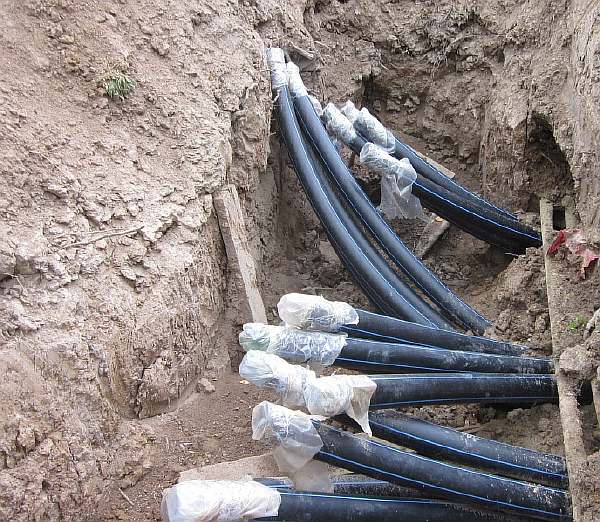
Norms
The distance between the cable and the gas pipeline is also determined by the specifics of the transmission of electricity. Gas pipelines can be underground and aboveground types, electricity can be transmitted through underground cable or overhead air lines. The distance from the communication cable in the airspace depends on the security zone of the power transmission line, the power and mode of operation of the electrical installation.

In an underground cable network, everything depends on the voltage class and insulation safety, the proximity of other objects, their size and purpose.A safety zone is provided for power lines, the dimensions of which are marked in the form of a geometrically calculated polygon. An underground cable can be equipped with additional devices that make it possible to reduce the distance.
In addition to Decree of the Government of the Russian Federation No. 169, which determines the procedure for installing security zones, rules for the arrangement and provision of transportation of electricity and the organization of security measures, there is GOST 13109-97 "Electric Energy", GOST 14254-2015 "Degrees of protection provided by shells", technical rules operation of consumer electrical installations (PTEEP) and SNiP 21-01-97 "Fire safety of buildings and structures".
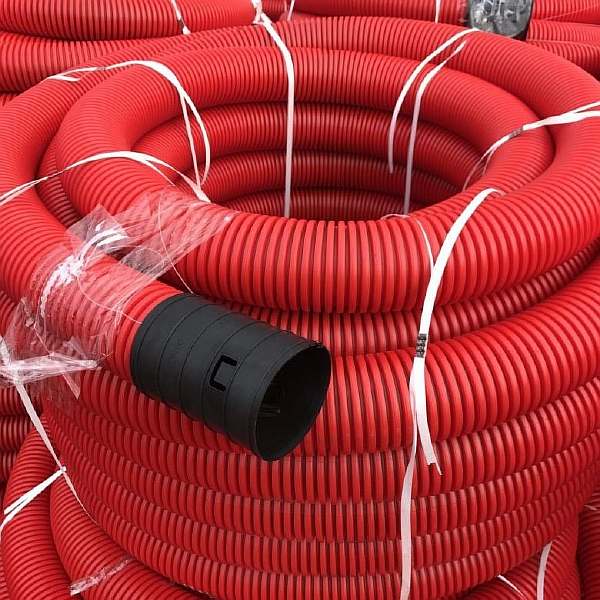
The rules for the installation of electrical installations have been repeatedly edited and adjusted. They are aimed at preventing possible violations in case of non-observance of distances. The regulation of the Ministry of Energy, for example, has a minimum distance between sockets for electrical appliances and a gas pipe in a room.
It is set at 50 cm to prevent the possibility of an explosion of domestic gas if a spark occurs in the socket. In other cases, there are many nuances
Particular attention is paid to the distance from the cable to the above-ground location or location in the ground of facilities for the transportation of natural gas or energy.
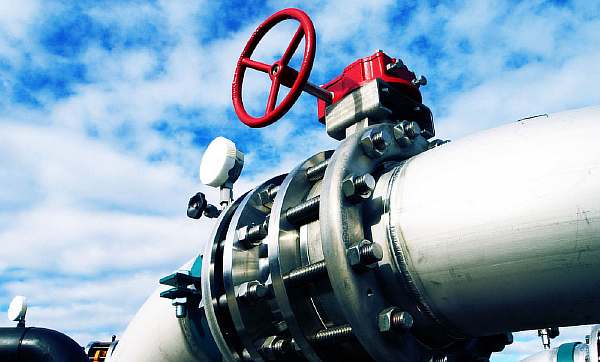
Equipment for electrochemical protection ECP
Electrochemical protection is used to protect various metal structures, gas pipelines and oil pipelines, as well as to protect oil and gas field stationary structures. Electrochemical protection of pipelines significantly extends their service life and eliminates the most important danger - unscheduled repairs. Each element of underground utilities has its own resource, service life. After this time, it is necessary to carry out a scheduled replacement. However, due to corrosion (which is inevitable in old pipes), the estimated service life is significantly adjusted. And only electrochemical protection helps protect yourself from surprises, save decent money and avoid accidents. This section presents only a small part of the electrochemical protection products supplied by GSS JSC (as an example), for complete information on electrochemical protection products, you need to contact the relevant department.
SCOPE OF APPLICATION OF THE MAIN TYPES OF ECP EQUIPMENT:
Cathodic protection stations
Unified set of electrochemical protection system UKS ECP
Designed to provide electrochemical protection of underground gas pipelines and other underground structures from corrosion, according to design solutions. The production of UKS ECP can be carried out in the form of two or more sets, which are manufactured according to separate questionnaires for one object. The UKS ECP can include equipment or materials of individual design, their variability allows you to meet any customer requirements.
Anode grounding deep / surface
SCOPE OF APPLICATION OF METERING AND CONTROL DEVICES
Indicators of corrosion processes of the IKP series
FIELD OF APPLICATION OF MATERIALS FOR ECP MOUNTING
Thermite pencil TU 1793-004-43750384-2006
Electrochemical protection rods TU 1718-001-56222072-2005
ELECTRIC INSULATING PLATE "LITOMET"TU 1469-025-63341682-2017
DESCRIPTION:
electrically insulating lodgement "Litomet" is an electrically insulating gasket designed to exclude any electrical contact between steel overground pipelines and metal supports, and structures, as well as to protect the insulating coating of pipelines from mechanical damage. The products have been approved for use by PJSC Gazprom.
APPLICATION AREA:
the product is mounted on pipeline supports of various types in all climatic zones according to GOST 15150-69 at an ambient temperature from minus 60˚С to plus 60˚С.
BENEFITS:
- increase the service life of above-ground pipelines due to a robust structure that is not subject to deformation over time (creep);
- protection of anti-corrosion insulation of pipelines from mechanical damage during pipeline laying;
- protection of the pipe material from stray currents;
- protection of the pipe material from the reduction of ECP currents;
- protection of the pipe material from damage due to galvanic and crevice corrosion.
The main characteristics of the electrically insulating lodgement "Litomet"
Plants with extended or distributed anodes
When using a corrosion protection transformer station, the current is distributed along a sinusoid. This adversely affects the protective electric field. There is either excessive voltage at the place of protection, which entails a high consumption of electricity, or an uncontrolled leakage of current, which makes the electrochemical protection of the gas pipeline ineffective.
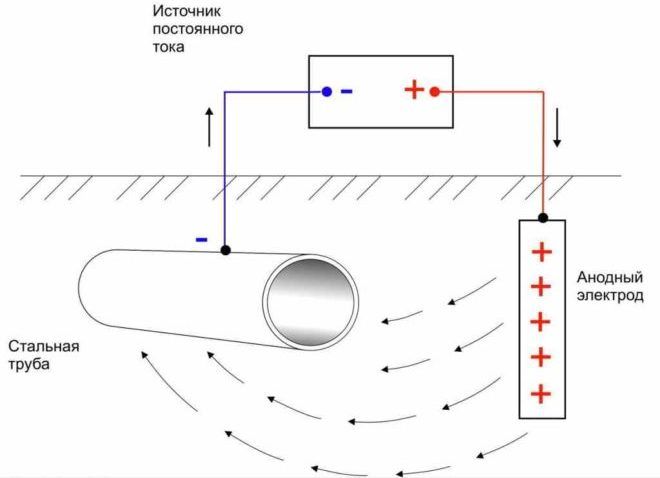
The practice of using extended or distributed anodes helps to circumvent the problem of uneven distribution of electricity. The inclusion of distributed anodes in the gas pipeline electrochemical protection scheme helps to increase the corrosion protection zone and smooth the voltage line. Anodes with this scheme are placed in the ground, throughout the entire gas pipeline.
Adjusting resistance or special equipment provides a change in current within the required limits, the voltage of the anode ground changes, with the help of which the protective potential of the object is regulated.
If several grounding conductors are used at once, the voltage of the protective object can be changed by changing the number of active anodes.
The ECP of a pipeline by means of protectors is based on the potential difference between the protector and the gas pipeline located in the ground. The soil in this case is an electrolyte; the metal is restored, and the body of the protector is destroyed.
Video: Protection against stray currents
A selection of questions
- Mikhail, Lipetsk — What discs for metal cutting should be used?
- Ivan, Moscow — What is the GOST of metal-rolled sheet steel?
- Maksim, Tver — What are the best racks for storing rolled metal products?
- Vladimir, Novosibirsk — What does ultrasonic processing of metals mean without the use of abrasive substances?
- Valery, Moscow — How to forge a knife from a bearing with your own hands?
- Stanislav, Voronezh — What equipment is used for the production of galvanized steel air ducts?
3 Anode grounds
6.3.1 In installations
cathodic protection, deep and subsurface anode
grounding. Subsurface groundings can be concentrated,
distributed and extended.
6.3.2 Anode
grounding (including DC lines and contact nodes) regardless of
operating conditions should be designed for a service life of at least 30
years.
6.3.3 Anode
grounding (ground electrodes) must be allowed for use at the facilities of OJSC
"Gazprom". When designing grounding, one should take into account the specific
electrical resistance of the soil at the location of the grounding, as well as
land use conditions. Anode grounding electrodes should be mounted in places
with a minimum electrical resistivity of the soil and below its depth
freezing.
6.3.4 Criteria
choice of locations for anode grounding are:
- priority
ensuring the standard parameters of cathodic protection of the most responsible
communications;
- areas with
soils of the lowest electrical resistivity;
- limitation
negative (harmful) impact on third-party underground utilities with separate
protection (including areas with local protection).
6.3.5 Type and
the number of anode grounding conductors is determined taking into account the requirements for the value
spreading resistance at the initial moment of operation, given in.
6.3.6 Anode
grounding must not have a harmful effect on the environment.
AZ located
in the horizons of drinking water, must be made of slightly soluble
materials: carbonaceous, magnetite or high-silicon cast iron.
6.3.7 When
when designing anode groundings, compliance with regulatory
indicators of the Rules []
in terms of requirements for step voltage and touch voltage.
6.3.8 For
underground laying of cables in anode grounding circuits, a cable should be used
with copper conductors and with polyethylene or polypropylene insulation
and shell. Cross section of the anode drainage cable connected to the positive
terminal of the cathode converter, must be at least 16 mm2
copper.
6.3.9 Deep
anode grounding (GAS) should be placed at a distance not closer than 100
m from adjacent communications, subject to exception
negative influence.
6.3.10 In permafrost
GAS should be designed predominantly in areas with cryopegs or below
permafrost horizon. In difficult geological conditions (rocky,
permafrost soils) it is possible to place anode groundings in one
pipeline trench.
6.3.11 Electrodes
distributed anode grounding and extended grounding of UKZ underground
communications should be placed along the protected structure, as a rule, on
distance not closer than four of its diameters on the linear part. In cramped
conditions of an industrial site, it is allowed to lay in one trench on
the maximum distance from the structure while providing measures to eliminate
direct contact between the anode and the structure.
6.3.12 Connecting cables
extended anode grounding when connected in series should
carried out at separate control and measuring points for diagnostics
separate grounding elements.
6.3.13 On
industrial sites of CGTP, CS, UGS facilities in the presence of several wells for one UKZ
GAS located at a distance closer than 1/3 of their depth, designed deep
anodes must be equipped with devices for measuring and regulating the value
current flowing from them.
5. Safety of gas supply systems and pipelines.
At enterprises for storing gas reserves and for technological purposes, gas holders are installed - low and high pressure.
Low-pressure gas holders are used as spare tanks, as devices for gas purification from mechanical impurities and ensuring the uniformity of its supply, as well as for other purposes. The gas in them is under pressure from 1.5 to 4 kPa. High-pressure gas holders are designed to create gas containers that supply it at a constant high pressure (up to 1.5 MPa) for technological needs (for gas furnaces, metal cutting, etc.).
Gases from main networks to tanks and from them to consumers are transferred through pipelines, which are transport devices. Due to the wide variety of gases used, the identification color of pipelines (GOST 14202-66) is established, presented in Table. 27.
Arrangement, manufacture, installation, testing and acceptance of pipelines are carried out in accordance with the Rules for the Arrangement and Safe Operation of Pressure Vessels, as well as the Rules for the Arrangement and Safe Operation of Stationary Compressor Units, Air Ducts and Gas Pipelines.
It is advisable to mount gas pipelines on brackets or special supports so that you can observe their serviceability, check the tightness and thereby prevent the danger of explosions and poisoning in case of gas leaks.
Acetylene pipelines, depending on the working pressure of acetylene, are divided into three groups: low pressure - 0.01 MPa; medium - over 0.01 to 0.15 MPa and high - over 0 15 to 3 MPa.
Oxygen pipelines, depending on the working pressure of oxygen, are divided into three groups: low pressure - up to 0.07 MPa; medium - over 0.07 to 1.6 MPa and high - over 1.6 MPa.
Acetylene pipelines of all three groups and oxygen pipelines of low and medium pressure are made of seamless steel pipes. Aboveground high-pressure oxygen pipelines are made only from red-copper or brass pipes. In threaded connections of oxygen pipelines, it is forbidden to use winding from flax, hemp or wiping ends, as well as lubrication with red lead and other materials containing fats. For impregnation or lubrication of such compounds, lead litharge mixed with distilled water is used.
In flange and fitting connections of oxygen pipelines, the use of gaskets made of organic material (cardboard, rubber, paronite, etc.) is prohibited. Depending on the pressure, the use of asbestos cardboard or metal gaskets made of aluminum or annealed copper is allowed.
Gas pipelines must be grounded by connecting them to the ground loop, and also provided with conductive jumpers on all flange connections.
In order to prevent deformation of the pipeline from temperature fluctuations and the occurrence of forces transmitted to the machines and devices connected to it, the possibility of free thermal expansion of the pipeline is provided, for which compensating devices are installed.
Air ducts and gas pipelines are laid with a slope of 0.003 towards linear water separators, preventing the formation of zones where condensate or oil can accumulate. All devices for removing oil and water from the air duct should be checked regularly.
Heating of these devices when they are frozen is only allowed with hot water, steam or hot air. Valves, gate valves, valves must be constantly in full working order and provide at any time a quick and reliable interruption of the supply of air or gas.
Apparatus and pipelines located at workplaces in the main passages with a surface temperature above +45 ° C must have thermal insulation.
Device
Anode ground electrodes work as follows. Being in the electrolyte, various metals have excellent electrode potentials. Therefore, if “-” is run through the pipeline from a constant source of electricity, and an electrode consisting of magnesium aluminum or zinc is placed in the immediate vicinity of the pipe, to which “+” will be connected, then these metals in relation to ordinary steel in the electrolyte will perform the function anode.
This element, in this electrochemical system, will self-destruct in the soil, thereby protecting the cathode, that is, the gas pipeline or other communications, from corrosion.
Similarly, underground metal tanks and other objects that are made of corrosive material can be protected from destruction. In order to ensure the protection of underground metal objects at the proper level, it is necessary not only to choose a high-quality anode ground electrode system, but also to correctly carry out installation work.
1. General Provisions
To reduce and maintain gas pressure in gas distribution and gas consumption networks within the specified limits, regardless of gas consumption, the following GRPs are provided: gas control points (GRP), block gas control points (GRPB), cabinet gas control points (GRPSH), underground gas reduction points (PRGP) and gas control units (GRU), which comply with this section and GOST R 56019, and GRPB and GRPSH - additionally with GOST R 54960.
For gas metering, if necessary, gas metering points (PUG), including block and cabinet ones, and gas metering units as part of the GRU can be provided.
(New edition. Rev. No. 2)
5 Drain protection installations
6.5.1 Accepted
technical solutions in the design of drainage protection based on the results
surveys and taking into account the relative position of the source of stray currents and
of the protected structure are specified at the stage of commissioning.
6.5.2 RHD should
design, as a rule, in the anode and alternating zones on the underground
construction.
6.5.3 Settings
drainage protection should be designed at the intersection with the structure and / or
proximity to the source of stray currents. When the structure is removed from the source
stray currents over a distance of more than 1000
m, as well as if it is impossible to connect to them UDZ
BCC should be used with automatic maintenance of the protective potential.
6.5.4 RHD should
design in such a way that the average hourly current of all UDZ connected
electrically to one traction substation, did not exceed 20% of the total load
substations.
6.5.5 Technical
conditions and scheme for connecting the drainage cable UDZ to the source of stray currents
must be coordinated with the operating service of the stray current source.
grounding
6. Power supply UNP2-7-65
The enclosures of the switchboard, the UNP unit, the compressor, the air heater are connected by a common ground wire, which is led to the ground bolt installed on the vehicle frame on the left side. This bolt must be connected to h.
7. Air heater for UNP2-7-65
2. Check the ground connection to the control panel. 6.3. Open the control panel. Make sure that there is no moisture or dirt inside the control panel and check the position of the handles of the RCD switches and the "Heating" machine: the RCD must be turned on (knob .
9. Installation of intrashop pipelines
What are the minimum distances allowed between the axes of the laid pipes? 4. Tell us about the rules for grounding pipelines for the removal of static electricity. .
PGS flexible and shunt jumpers, grounding shunts, conductors and grounding wires for grounding metal structures.
Jumper PGS and PGM.
1.Purpose PGS jumpers are used for grounding metal structures, machine bodies, apparatuses.
2. Normal operation is ensured by the following conditions:
- Height above sea level is not more than 1000m.
- Air temperature from -45С to +45С.
- Relative air humidity is not more than 85% at a temperature of +20C.
- The environment is not explosive, does not contain aggressive gases and vapors in concentrations that destroy metal and insulation.
The pulling force of the rope from the ends of the jumpers is at least 50N. The jumper rope PGS is made of galvanized steel rope, the tips are made of steel with a metal coating.
3. Delivery set
4. Operation and indication of safety measures – Installation and operation of the PGS jumpers must comply with the “Rules for Technical Operation”. Commissioning is carried out by the installation organization.
5. Storage information Storage should be carried out in dry enclosed spaces at temperatures from -20C to +40C.
6. Acceptance certificate Serial batch number No. passed the test and tests, and were found fit for use.
Date of issue: In accordance with the current "Nomenclature of products and services (works), in respect of which the legislative acts of the Russian Federation provide for their mandatory certification" PGS jumper products are not subject to mandatory certification.
7. Warranty The enterprise - manufacturer (supplier) guarantees trouble-free operation for 5 years from the date of manufacture, provided that the consumer observes the conditions of operation, transportation, storage and installation provided for by the technical specifications.
